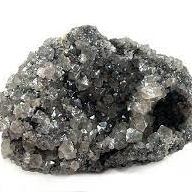Senarmontite: Gemstones Information
Senarmontite is a mineral of considerable importance in both mineralogy and industry due to its unique properties and applications. Below, we delve into the characteristics, occurrence, uses, and significance of Senarmontite.
Characteristics:
Senarmontite is a rare mineral that belongs to the oxide class, specifically the antimony oxides group. Its chemical formula is Sb₂O₃, consisting of two atoms of antimony bonded to three atoms of oxygen. Structurally, it crystallizes in the orthorhombic system, typically forming prismatic or tabular crystals. It can also occur in granular or massive forms. Senarmontite’s color ranges from colorless to white, gray, or yellowish, and it often exhibits a vitreous to adamantine luster.
Occurrence:
Senarmontite is primarily found in hydrothermal veins associated with antimony deposits. It forms under high-temperature and low-pressure conditions from the hydrothermal alteration of antimony-bearing minerals. Significant deposits of Senarmontite have been reported in various regions worldwide, including China, Mexico, Bolivia, and the United States. It may occur alongside other antimony minerals such as stibnite (antimony sulfide) and valentinite (antimony oxide).
Uses:
Senarmontite has several industrial and technological applications:
Antimony Production: Senarmontite serves as an important ore of antimony, a metalloid used primarily in the production of alloys, flame retardants, and lead-acid batteries. It is a key source of antimony oxide, which is further processed to produce metallic antimony and antimony compounds.
Flame Retardants: Antimony oxide, derived from Senarmontite, is widely used as a flame retardant in plastics, textiles, and other materials. It suppresses the ignition and spread of fires by releasing water vapor and forming a protective char layer when exposed to heat.
Catalysts: Antimony oxide-based catalysts, derived from Senarmontite, find application in the production of polyester fibers, polyethylene terephthalate (PET) resins, and other polymerization processes. These catalysts facilitate chemical reactions and improve the efficiency of industrial processes.
Glass and Ceramics: Senarmontite is utilized in the manufacturing of glass and ceramic products, where it acts as an opacifying agent, imparting opacity and white coloration to the final products. It enhances the mechanical strength and thermal properties of glass and ceramic materials.
Significance:
Senarmontite holds significance in the fields of mineralogy, geology, and industrial chemistry:
Mineralogical Research: Senarmontite contributes to our understanding of ore-forming processes and mineral assemblages associated with antimony deposits. Its occurrence and properties provide valuable insights into the geochemical behavior of antimony and the formation of hydrothermal ore deposits.
Industrial Applications: Senarmontite plays a vital role in various industries, including metallurgy, plastics, textiles, and ceramics. Its unique properties, such as flame retardancy and catalytic activity, make it indispensable in the production of a wide range of materials and products.
Economic Importance: Senarmontite, as an ore of antimony, contributes to the global economy by supplying raw materials for antimony production and its derivatives. The demand for antimony and its compounds in diverse industrial sectors underscores the economic significance of Senarmontite-bearing deposits.
In conclusion, Senarmontite, with its rare occurrence and valuable properties, plays a significant role in both mineralogical research and industrial applications. As a key ore of antimony, it supports various technological advancements and contributes to the production of essential materials used in everyday life.





